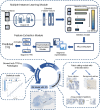A weakly supervised deep learning framework for automated PD-L1 expression analysis in lung cancer
- PMID: 40230846
- PMCID: PMC11994606
- DOI: 10.3389/fimmu.2025.1540087
A weakly supervised deep learning framework for automated PD-L1 expression analysis in lung cancer
Abstract
The growing application of immune checkpoint inhibitors (ICIs) in cancer immunotherapy has underscored the critical need for reliable methods to identify patient populations likely to respond to ICI treatments, particularly in lung cancer treatment. Currently, the tumor proportion score (TPS), a crucial biomarker for patient selection, relies on manual interpretation by pathologists, which often shows substantial variability and inconsistency. To address these challenges, we innovatively developed multi-instance learning for TPS (MiLT), an innovative artificial intelligence (AI)-powered tool that predicts TPS from whole slide images. Our approach leverages multiple instance learning (MIL), which significantly reduces the need for labor-intensive cell-level annotations while maintaining high accuracy. In comprehensive validation studies, MiLT demonstrated remarkable consistency with pathologist assessments (intraclass correlation coefficient = 0.960, 95% confidence interval = 0.950-0.971) and robust performance across both internal and external cohorts. This tool not only standardizes TPS evaluation but also adapts to various clinical standards and provides time-efficient predictions, potentially transforming routine pathological practice. By offering a reliable, AI-assisted solution, MiLT could significantly improve patient selection for immunotherapy and reduce inter-observer variability among pathologists. These promising results warrant further exploration in prospective clinical trials and suggest new possibilities for integrating advanced AI in pathological diagnostics. MiLT represents a significant step toward more precise and efficient cancer immunotherapy decision-making.
Keywords: MiLT; PD-L1; TPS; automated scoring; lung cancer.
Copyright © 2025 Jiao, Shang, Lu, Chen, Chen, Xiao, Zhang, Zhang, Lv and Han.
Conflict of interest statement
All authors affiliated with 3D Medicines Inc. are current or former employees. The remaining authors declare that the research was conducted in the absence of any commercial or financial relationships that could be construed as a potential conflict of interest.
Figures





Similar articles
-
Clinical Validation of Artificial Intelligence-Powered PD-L1 Tumor Proportion Score Interpretation for Immune Checkpoint Inhibitor Response Prediction in Non-Small Cell Lung Cancer.JCO Precis Oncol. 2024 May;8:e2300556. doi: 10.1200/PO.23.00556. JCO Precis Oncol. 2024. PMID: 38723233
-
Artificial intelligence-powered programmed death ligand 1 analyser reduces interobserver variation in tumour proportion score for non-small cell lung cancer with better prediction of immunotherapy response.Eur J Cancer. 2022 Jul;170:17-26. doi: 10.1016/j.ejca.2022.04.011. Epub 2022 May 14. Eur J Cancer. 2022. PMID: 35576849
-
Comparative performance of PD-L1 scoring by pathologists and AI algorithms.Histopathology. 2025 Jul;87(1):90-100. doi: 10.1111/his.15432. Epub 2025 Feb 17. Histopathology. 2025. PMID: 39961605 Free PMC article.
-
Single or combined immune checkpoint inhibitors compared to first-line platinum-based chemotherapy with or without bevacizumab for people with advanced non-small cell lung cancer.Cochrane Database Syst Rev. 2020 Dec 14;12(12):CD013257. doi: 10.1002/14651858.CD013257.pub2. Cochrane Database Syst Rev. 2020. Update in: Cochrane Database Syst Rev. 2021 Apr 30;4:CD013257. doi: 10.1002/14651858.CD013257.pub3. PMID: 33316104 Free PMC article. Updated.
-
Single or combined immune checkpoint inhibitors compared to first-line platinum-based chemotherapy with or without bevacizumab for people with advanced non-small cell lung cancer.Cochrane Database Syst Rev. 2021 Apr 30;4(4):CD013257. doi: 10.1002/14651858.CD013257.pub3. Cochrane Database Syst Rev. 2021. PMID: 33930176 Free PMC article.
References
MeSH terms
Substances
LinkOut - more resources
Full Text Sources
Medical
Research Materials

